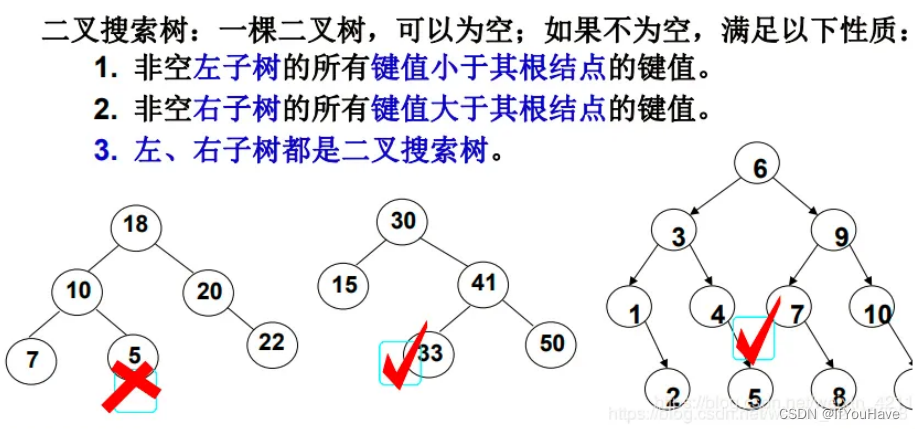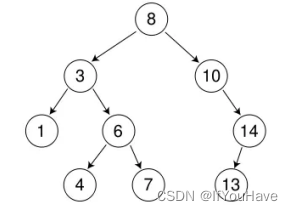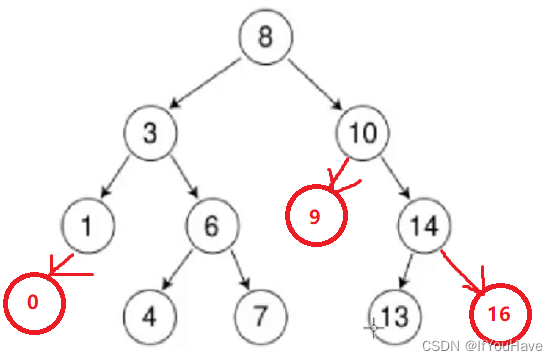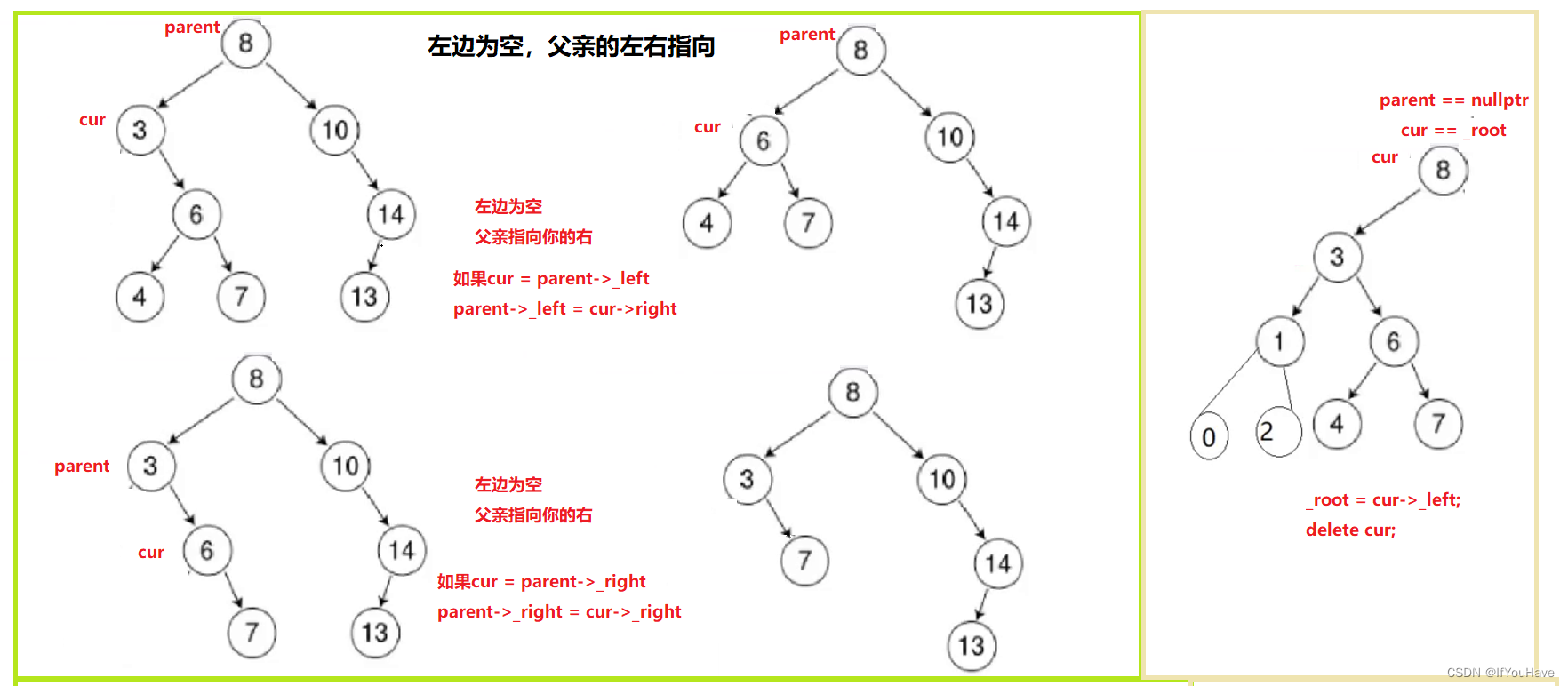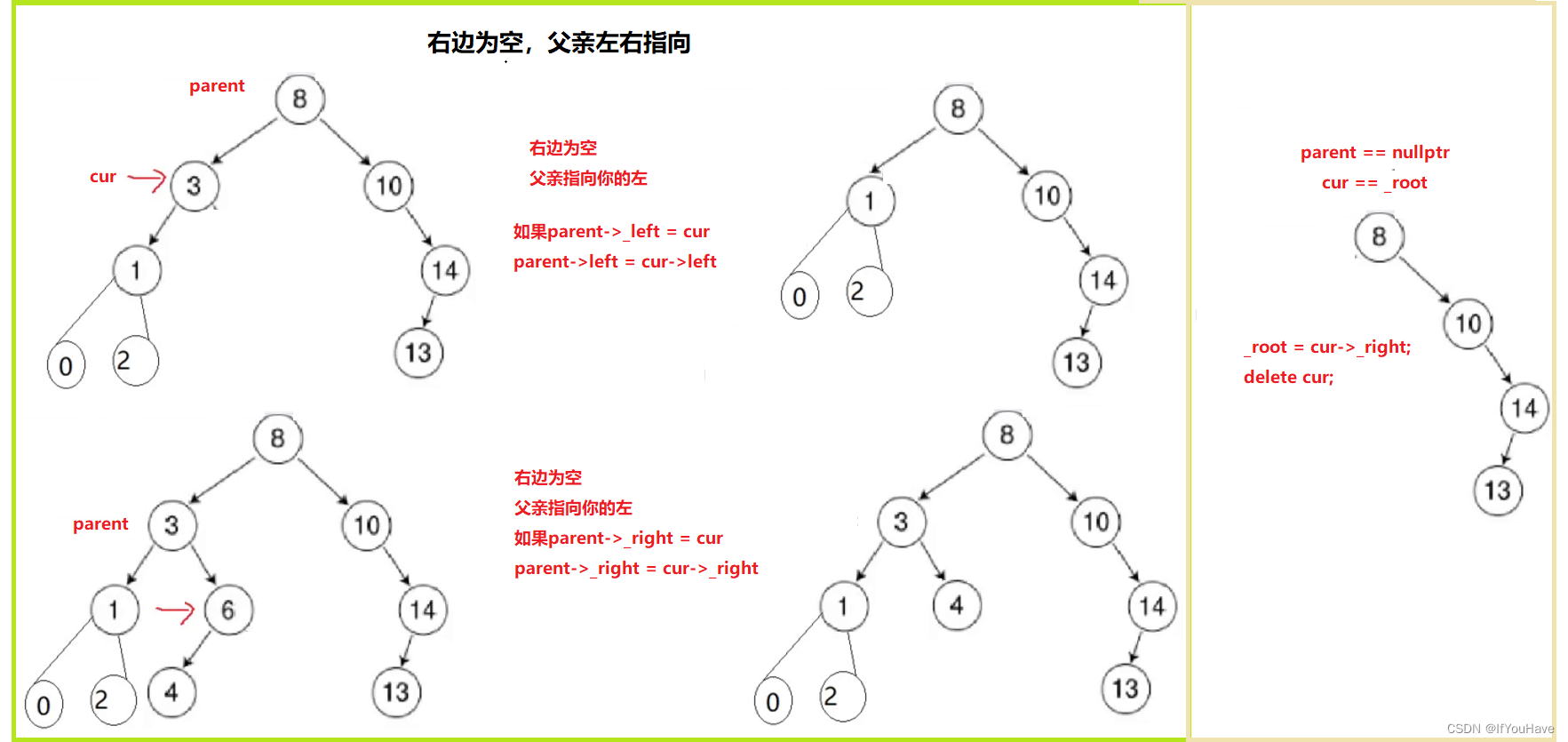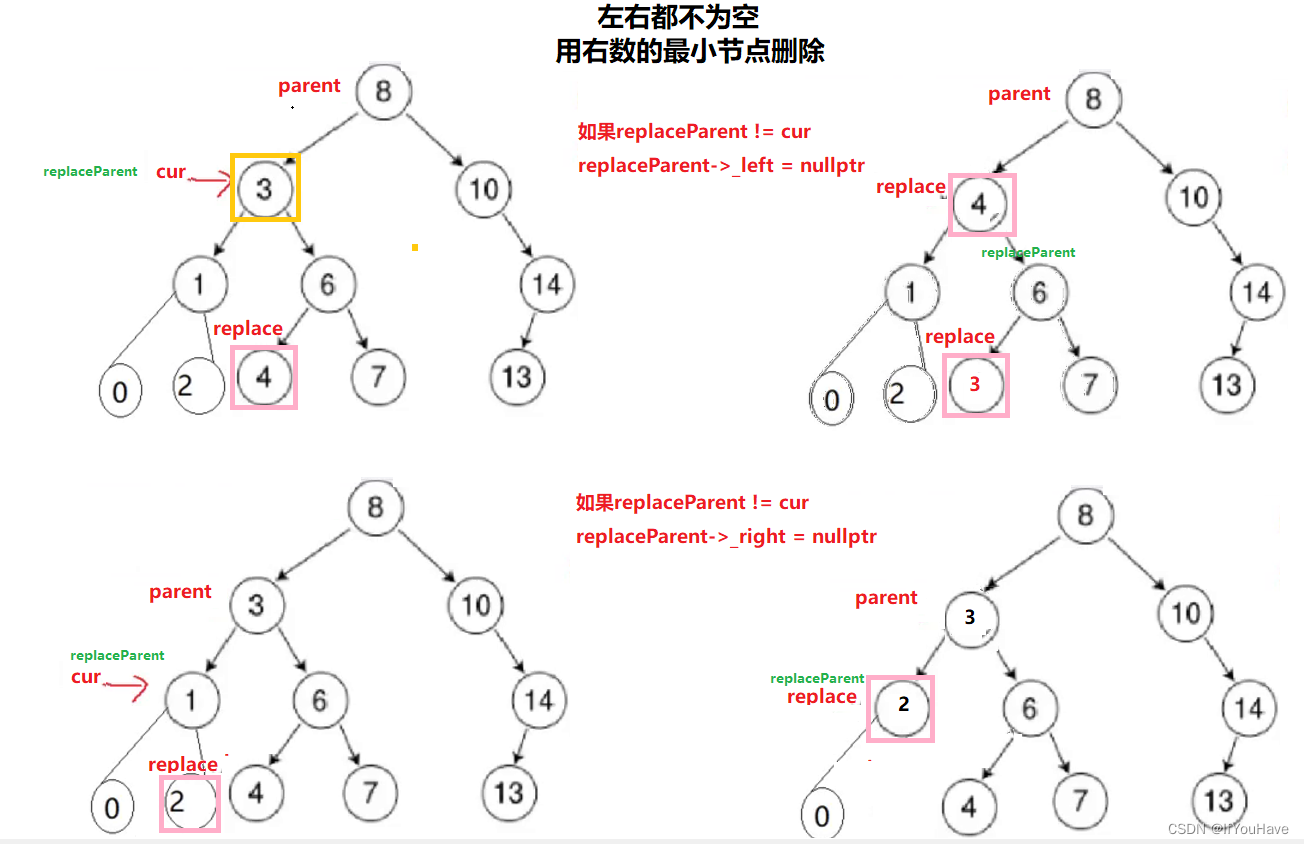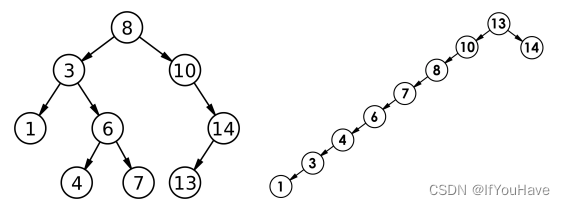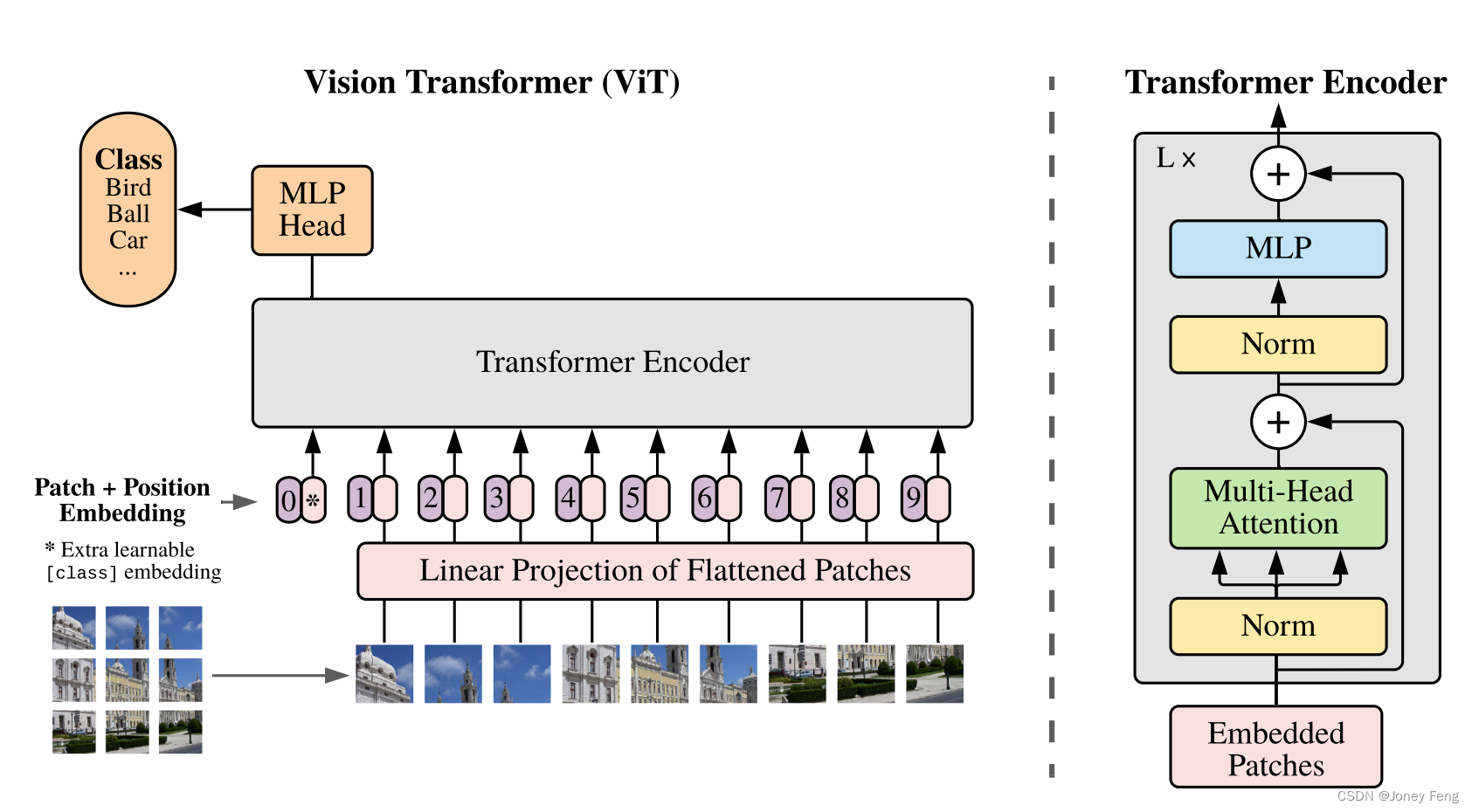
目录
0. 前言
1. 二叉搜索树概念
2. 二叉搜索树操作
3. 二叉搜索树的实现
3.1 非递归实现插入操作Insert
3.2 二叉搜索树中序遍历递归实现(排序)
3.3 非递归实现查找操作Find
3.4 非递归实现删除操作Erase
3.5 递归实现插入操作InsertR
3.5 递归实现查找操作FindR
3.6 递归实现删除操作EraseR(递归引用的价值)
4.二叉搜索树的拷贝赋值析构&&其他操作
4.1 二叉树的拷贝构造
4.2 二叉搜索树的赋值
4.3 二叉搜索树的析构
4.4 二叉搜索树的其他操作
5. 二叉搜索树的性能分析
0. 前言
以下是前面有关二叉树的文章:
二叉树和堆
二叉树链式结构的实现
二叉树层序遍历
更新C++二叉树进阶是因为:
- map和set特性需要先铺垫二叉搜索树,而二叉搜索树也是一种树形结构
- 二叉搜索树的特性了解,有助于更好的理解map和set的特性
- 二叉树中部分面试题稍微有点难度,在前面学习不容易接受,且时间长容易忘
- 有些OJ题使用C语言方式实现比较麻烦,比如有些地方要返回动态开辟的二维数组,非常麻烦。
因此最近有关二叉树搜索树的文章,是对二叉树部分进行收尾总结。
1. 二叉搜索树概念
二叉搜索树又称二叉排序树,它或者是一棵空树,或者是具有以下性质的二叉树:
- 若它的左子树不为空,则左子树上所有节点的值都小于根节点的值
- 若它的右子树不为空,则右子树上所有节点的值都大于根节点的值
- 它的左右子树也分别为二叉搜索树
2. 二叉搜索树操作
int a[] = {8, 3, 1, 10, 6, 4, 7, 14, 13};
1. 二叉搜索树的查找
a、从根开始比较,查找,比根大则往右边走查找,比根小则往左边走查找。
b、最多查找高度次,走到到空,还没找到,这个值不存在。
2. 二叉搜索树的插入具体过程如下:
a. 树为空,则直接新增节点,赋值给root指针
b. 树不空,按二叉搜索树性质查找插入位置,插入新节点
如下插入0、9、16
3. 二叉搜索树的删除
首先查找元素是否在二叉搜索树中,如果不存在,则返回, 否则要删除的结点可能分下面四种情况:
- a. 要删除的结点无孩子结点
- b. 要删除的结点只有左孩子结点
- c. 要删除的结点只有右孩子结点
- d. 要删除的结点有左、右孩子结点
看起来有待删除节点有4中情况,实际情况a可以与情况b或者c合并起来,因此真正的删除过程如下:
假设删除的节点为cur,parent为cur的父节点,绘图分析
情况b:删除该结点且使被删除节点的双亲结点指向被删除节点的左孩子结点--直接删除
情况c:删除该结点且使被删除节点的双亲结点指向被删除结点的右孩子结点--直接删除
情况d:在它的右子树中寻找中序下的第一个结点(关键码最小),用它的值填补到被删除节点 中,再来处理该结点的删除问题--替换法删除
3. 二叉搜索树的实现
注:C++11新增用法,构造函数关键字default,强制生成默认构造
#pragma once #include<iostream> #include<vector> #include<algorithm> using namespace std;template<class K> class BSTreeNode { public:BSTreeNode(const K& key):_key(key),_left(nullptr),_right(nullptr){}BSTreeNode<K>* _left;BSTreeNode<K>* _right;K _key; };//key template<class K> class BinarySearchTree {typedef BSTreeNode<K> Node; public:/*BinarySearchTree() :_root(nullptr){}*///强制编译器生成默认构造 —— c++11用法,defaultBinarySearchTree() = default; private:Node* _root = nullptr; };二叉受搜索树采用链式结构,左右孩子进行实现
3.1 非递归实现插入操作Insert
bool Insert(const K& key) {if (_root == nullptr) {_root = new Node(key);return true;}Node* cur = _root;Node* parent = nullptr;while (cur) {parent = cur;if (cur->_key > key) {cur = cur->_left;}else if(cur->_key < key) {cur = cur->_right;}else {return false;}}if (parent->_key > key) {parent->_left = new Node(key);return true;}else{parent->_right = new Node(key);return true;}}
3.2 二叉搜索树中序遍历递归实现(排序)
二叉搜索树也叫做二叉排序树,因为其结构性质导致了按照中序遍历,便可以得到有序数据!
public:void InOrder() {_InOrder(_root);cout << endl;}private:void _InOrder(Node* root) {if (root == nullptr) {return;}_InOrder(root->_left);cout << root->_key << " ";_InOrder(root->_right);}注:由于递归需要穿参,遍历二叉树左右子树,而首要传参为根节点,根节点便是this的成员变量,可以直接访问,且缺省参数不可以使用成员变量(缺省参数必须是常量),如果在外传参,需要使用getRoot获取根节点,在传递,使用不便,因此只需要在内部套一层private修饰的成员函数,只可以类内部访问,使其在使用上和普通成员函数无差异!!!
3.3 非递归实现查找操作Find
bool Find(const K& key) const {if (_root == nullptr) {return false;}Node* cur = _root;while (cur) {if (cur->_key > key) {cur = cur->_left;}else if (cur->_key < key) {cur = cur->_right;}else {return true;}}return false;}
3.4 非递归实现删除操作Erase
bool Erase(const K & key) {if (_root == nullptr) {return false;}Node* cur = _root;Node* parent = nullptr;while (cur) {if (cur->_key > key) {parent = cur;cur = cur->_left;}else if (cur->_key < key) {parent = cur;cur = cur->_right;}else {if (cur->_left == nullptr) {if (cur == _root) {_root = cur->_right;}else{if (cur == parent->_left) {parent->_left = cur->_right;}else {parent->_right = cur->_right;}}delete cur;cur = nullptr;return true;}else if (cur->_right == nullptr) {if (cur == _root) {_root = cur->_left;}else {if (cur == parent->_left) {parent->_left = cur->_left;}else {parent->_right = cur->_left;}}delete cur;cur = nullptr;return true;}else {//替换法删除 -- 右数最小节点Node* replace = cur->_right;Node* replaceParent = cur;while (replace->_left != nullptr) {replaceParent = replace;replace = replace->_left;}std::swap(cur->_key, replace->_key);if (replaceParent->_left == replace) {replaceParent->_left = replace->_right;}else {replaceParent->_right = replace->_right;}delete replace;return true;}}}return false;}注: 采用替换法删除数据,因为二叉搜索树的性质,导致其元素如果重复便会插入失败,因此说明其可以自动去重,在删除时,由于每个元素数据不同,采用替换的方式更为高效易懂。
3.5 递归实现插入操作InsertR
public:bool InsertR(const K& key) {if (_root == nullptr) {_root = new Node(key);return true;}else {return _InsertR(_root, key);}} private:bool _InsertR(Node*& root, const K& key) {if (root == nullptr) {root = new Node(key);return true;}if (key > root->_key) {return _InsertR(root->_right, key);}else if (key < root->_key) {return _InsertR(root->_left, key);}else {return false;}}
3.5 递归实现查找操作FindR
public:bool FindR(const K& key) const {return _FindR(_root, key);} private:bool _FindR(Node* root,const K& key) const {if (root == nullptr) {return false;}if (key > root->_key) {return _FindR(root->_right, key);}else if (key < root->_key) {return _FindR(root->_left, key);}else {return true;}}
3.6 递归实现删除操作EraseR(递归引用的价值)
递归下引用传值的价值:
public:bool EraseR(const K& key) {return _EraseR(_root, key);} private:bool _EraseR(Node*& root ,const K& key) {if (root == nullptr) {return false;}if (key > root->_key) {return _EraseR(root->_right, key); }else if (key < root->_key) {return _EraseR(root->_left, key);}else {//删除数据Node* del = root;if (root->_left == nullptr) {root = root->_right;}else if (root->_right == nullptr) {root = root->_left;}else {Node* replace = root->_right;while (replace->_left != nullptr) {replace = replace->_left;}std::swap(root->_key, replace->_key);return _EraseR(root->_right, key);}delete del;return true;}}
4.二叉搜索树的拷贝赋值析构&&其他操作
4.1 二叉树的拷贝构造
二叉树的拷贝因每个节点都是new出来的,因此需要采用深拷贝,而拷贝不能改变树的结构,并保持节点左孩子有孩子指向相同,可以使用递归方式,采用先序遍历,先开辟根节点,再使根节点的左孩子指向左子树,有右孩子指向右子树递归,构建树
public:BinarySearchTree(const BinarySearchTree<K>& bst) {_root = _copy(bst._root);} private:Node* _copy(Node* root) {if (root == nullptr) {return nullptr;}Node* copyRoot = new Node(root->_key);copyRoot->_left = _copy(root->_left);copyRoot->_right = _copy(root->_right);return copyRoot;}注:虽然自定义类型构造函数生成的默认构造即可满足需求,但是拷贝构造完成的是值拷贝,会造成double free,因此重写拷贝构造时,拷贝构造也是构造,编译器不在生成默认构造,使用C++11新增的default关键字,强制编译器生成默认构造!
4.2 二叉搜索树的赋值
默认生成的赋值同样完成的是值拷贝,因此需要重写赋值操作,而赋值可以根据拷贝构造并使用现代写法,完成赋值运算
public:BinarySearchTree<K>& operator=(BinarySearchTree<K> bst) {std::swap(_root, bst._root);return *this;}
4.3 二叉搜索树的析构
因为使用了堆区空间,析构时需要遍历整棵树,而析构应采用后序遍历,使用分治思想,先析构左子树,在析构右子树,最终析构根节点,否者会找不到左右子树,会造成内存泄露!
void _destory(Node*& root) {if (root == nullptr) {return;}_destory(root->_left);_destory(root->_right);delete root;root = nullptr;}public:~BinarySearchTree() {_destory(_root);}
4.4 二叉搜索树的其他操作
求叶子节点个数、节点个数、树深度
public:int depth() const {return _depth(_root);}int nodeCount() const {return _nodeCount(_root);}int leafSize() const {return _leafSize(_root);} private:int _depth(Node* root) const {if (root == nullptr) {return 0;}int leftDepth = _depth(root->_left) + 1;int rightDepth = _depth(root->_right) + 1;return leftDepth > rightDepth ? leftDepth : rightDepth;}int _nodeCount(Node* root) const {if (root == nullptr) {return 0;}int leftCount = _nodeCount(root->_left) + 1;int rightCount = _nodeCount(root->_right) + 1;return leftCount + rightCount - 1;}int _leafSize(Node* root) const {if (root == nullptr) {return 0;}if (root->_left == nullptr && root->_right == nullptr) {return 1;}int leftSize = _leafSize(root->_left);int rightSize = _leafSize(root->_right);return leftSize + rightSize;}
5. 二叉搜索树的性能分析
插入和删除操作都必须先查找,查找效率代表了二叉搜索树中各个操作的性能。
对有n个结点的二叉搜索树,若每个元素查找的概率相等,则二叉搜索树平均查找长度是结点在二叉搜索树的深度的函数,即结点越深,则比较次数越多。
但对于同一个关键码集合,如果各关键码插入的次序不同,可能得到不同结构的二叉搜索树:
最优情况下,二叉搜索树为完全二叉树(或者接近完全二叉树),其平均比较次数为:log_2 N
最差情况下,二叉搜索树退化为单支树(或者类似单支),其平均比较次数为:frac{N}{2}
问题:如果退化成单支树,二叉搜索树的性能就失去了。那能否进行改进,不论按照什么次序插入关键码,二叉搜索树的性能都能达到最优?后续学习的二叉平衡搜索树、AVL树和红黑树
